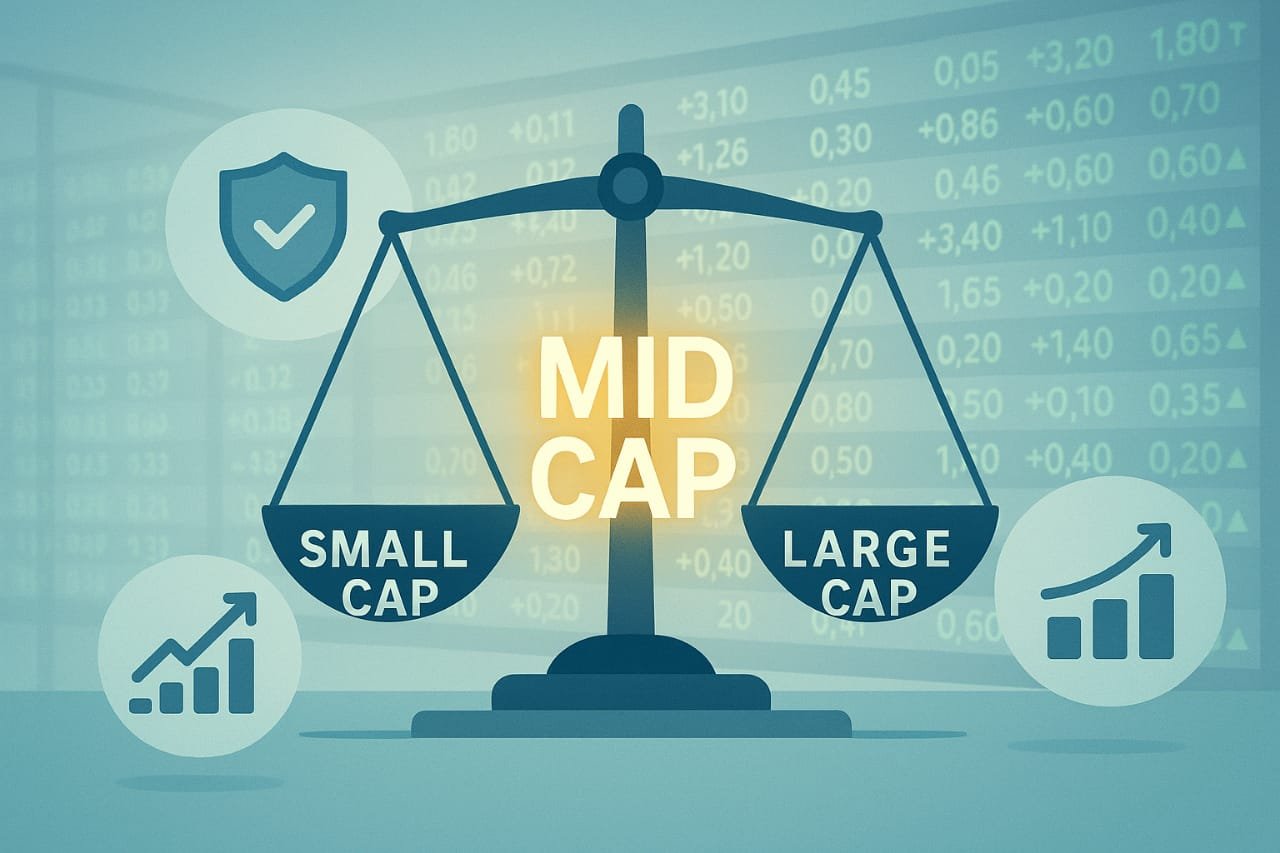Mid Cap Index: The Smart Investor’s Sweet Spot Explained
When most people think of the stock market, they immediately picture the giants—Reliance, Apple, TCS, or Amazon. But here’s the twist: some of the biggest wealth creators in the market today were once mid-cap stocks. This is where the Mid Cap Index comes into play—offering a sweet spot between stability and high growth potential.

In this post, we’ll dive deep into what the Mid Cap Index is, how it compares to other indices, and why investors—especially those looking for long-term wealth—should pay close attention to it.
📊 What Is the Mid Cap Index?
A Mid Cap Index is a benchmark index that tracks the performance of mid-sized companies listed on a stock exchange. These are companies that fall between small-cap and large-cap categories in terms of market capitalization.
✅ Market Capitalization Criteria:
-
Large Cap: Top 100 companies by market cap
-
Mid Cap: Ranked 101st to 250th
-
Small Cap: 251st and onwards
(Based on SEBI’s classification in India)
The most well-known mid-cap indices include:
-
Nifty Midcap 150 (India)
-
S&P MidCap 400 (USA)
-
Russell Midcap Index (USA)
Each of these tracks companies that are big enough to be stable, yet still small enough to offer significant growth.
🧭 Why the Mid Cap Index Deserves Attention
Mid-cap companies are like the teenagers of the corporate world—mature enough to stand on their feet but young enough to grow exponentially. Here’s why this index is especially important:
📈 High Growth Potential
-
Mid-cap companies often operate in growing sectors with expanding markets.
-
They are agile and can capitalize on trends faster than large enterprises.
🛡️ Better Risk-Reward Ratio
-
They carry less risk than small caps but offer better returns than large caps.
-
Historically, mid-caps have outperformed large caps during bull markets.
🧱 Diversified Exposure
-
Mid Cap Index funds include companies from various sectors—tech, finance, manufacturing, pharma—reducing sectoral risk.
🔍 Mid Cap vs Large Cap vs Small Cap
To make this more digestible, let’s compare the three across critical parameters:
| Feature | Small Cap Stocks | Mid Cap Stocks | Large Cap Stocks |
|---|---|---|---|
| Market Cap Rank | 251 and above | 101–250 | Top 100 |
| Growth Potential | Very High | High | Moderate |
| Volatility | Very High | Moderate to High | Low |
| Liquidity | Low | Moderate | High |
| Risk | High | Balanced | Low |
| Ideal For | Aggressive Investors | Growth-Oriented Investors | Conservative Investors |
🧠 Key Insights About the Mid Cap Index
1. Cyclic Behavior
Mid caps are more volatile than large caps. During bear markets, they can fall harder, but in bull runs, they rise sharper. For instance:
-
The Nifty Midcap 150 outperformed the Nifty 50 in 2021 by a wide margin, driven by economic recovery hopes.
-
But in correction phases, they tend to underperform due to weaker balance sheets.
2. Entry into Large Cap Club
Several mid-cap companies eventually graduate to large-cap status. Think Avenue Supermarts (DMart) or Page Industries—both were once mid caps.
This “graduation” often triggers institutional interest, further boosting their stock price.
3. Preferred by Mutual Funds
Mid-cap mutual funds in India and abroad often outperform their large-cap peers during growth phases. For example, according to Value Research, many mid-cap mutual funds delivered CAGR of 20%+ over the last 5 years (as of 2025).
💼 How to Invest in the Mid Cap Index
There are several ways to gain exposure to mid-cap stocks through the Mid Cap Index:

🔹 1. Index Funds
You can invest in funds that mirror the Mid Cap Index such as:
-
Nifty Midcap 150 Index Fund
-
S&P MidCap 400 ETF (MDY)
These funds aim to replicate the performance of the index without active management.
🔹 2. ETFs (Exchange-Traded Funds)
Mid-cap ETFs provide real-time trading like stocks while offering diversified exposure:
-
iShares Russell Mid-Cap ETF (IWR)
-
Motilal Oswal Midcap 150 ETF (India)
🔹 3. Mid-Cap Mutual Funds
These are actively managed and attempt to beat the benchmark:
-
Axis Midcap Fund
-
Kotak Emerging Equity Fund
-
Nippon India Growth Fund
Investors may choose between active and passive approaches depending on their risk appetite.
🧪 Risks Associated with Mid Cap Index Investing
While mid caps offer high growth potential, they come with unique risks:
🔺 Market Volatility
Mid caps are more sensitive to economic downturns, interest rate hikes, or global uncertainty.
🔺 Liquidity Concerns
In extreme market conditions, mid-cap stocks may witness lower trading volumes, impacting your ability to exit positions.
🔺 Business Risks
These companies might be undergoing expansion, making them more vulnerable to execution risk and capital constraints.
Tip: Always invest with a 3–5 year time horizon to ride out short-term volatility.
🧑💼 My Personal Take: Why I Include Mid Cap Index in My Portfolio
Having invested across large, mid, and small-cap segments, I’ve found mid caps offer the best blend of growth and resilience.
In 2020, I began SIPs in a mid-cap index fund (Motilal Oswal Midcap 150 ETF), and while the first few months were choppy, the returns have compounded significantly—especially during post-pandemic recoveries.
The key is to stay consistent, avoid panic-selling, and reap the benefits of long-term compounding.
🛠️ Tips to Maximize Returns from Mid Cap Index
-
📆 Think Long-Term: Invest with at least a 3-5 year horizon.
-
📊 Diversify: Don’t just invest in mid-caps—combine with large and small-cap for balance.
-
⏱️ Use SIPs: Systematic investments help average out the cost and reduce market timing risk.
-
🧮 Track Fundamentals: Mid-cap companies evolve quickly. Monitor quarterly results, expansion plans, and sectoral changes.
🔗 Internal & External Links for Readers
Internal Links:
External Links:
📣 Conclusion: Is the Mid Cap Index Right for You?
If you’re an investor looking for faster-than-average growth without going all-in on risky small caps, the Mid Cap Index offers a compelling middle ground. It balances the robustness of established businesses with the dynamism of fast-growing firms.

With proper risk management, a long-term view, and regular investments, mid-cap indices can be powerful wealth creators.
✅ Call to Action
Are you already investing in mid-cap stocks or funds? Or are you planning to start?
👉 Drop your thoughts or questions in the comments below!
🚀 Want more market insights like this? Subscribe to our newsletter for weekly updates, expert breakdowns, and smart investing tips.
